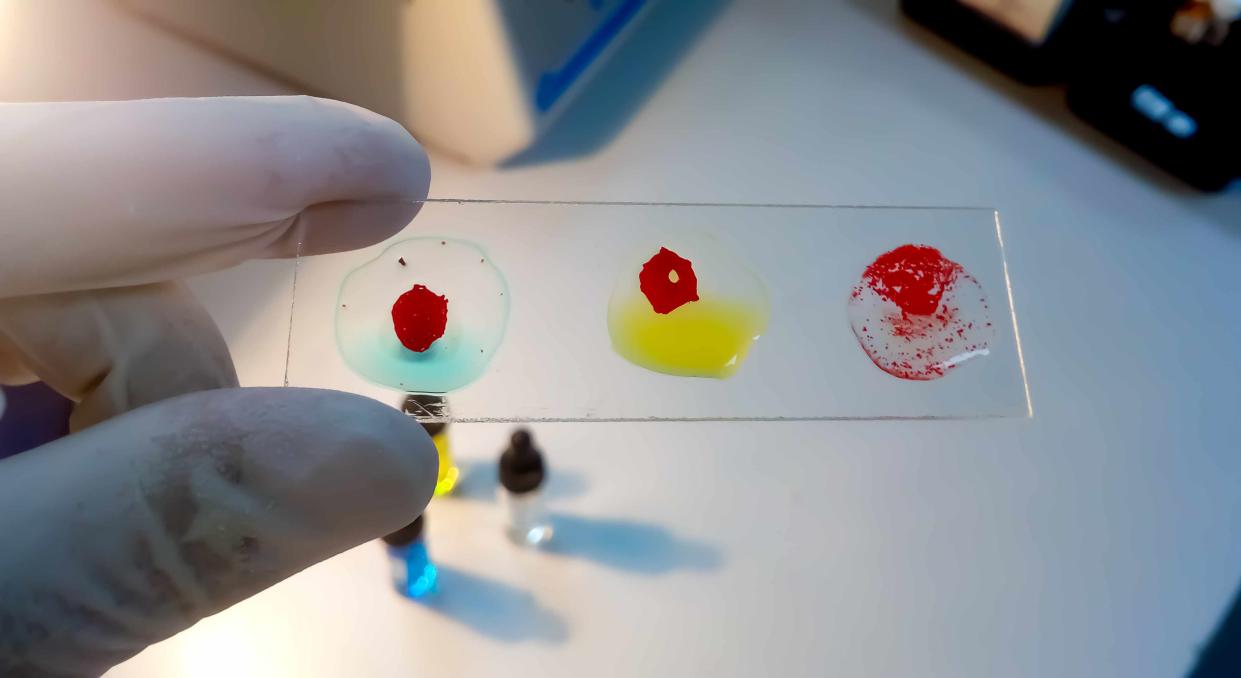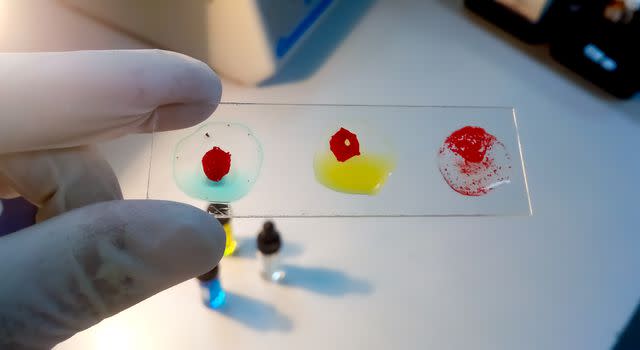What to Know About Blood Typing

Md Saiful Islam Khan / Getty Images
Medically reviewed by Steffini Stalos, DO
The blood type you have is categorized by certain substances on the surface of your red blood cells. Blood typing is a test to determine a person's ABO and Rh (the D antigen) type. These blood types are determined by your DNA and are inherited. It's essential to know your blood type if you need a blood transfusion or are pregnant.
This article will discuss blood typing and why and how it's done.

Md Saiful Islam Khan / Getty Images
The Blood Types
Blood types are categorized by the antigens (substances that produce an immune response) present or absent on the surface of red blood cells. Blood is typed by what is known as the ABO system and the Rh antigen.
In the ABO system, the four major blood types are:
A
B
AB
O
The letters represent the antigens that are present on the red blood cell (RBC) surface. You may have antigens known as A on the red blood cell surface, which means you have type A blood, or B antigens, which means you have type B blood. If you have both A and antigens, you have type AB blood. If neither A nor B antigens are present on the red blood cell surface, your blood type is O.
Rh blood typing identifies the presence or absence of the D antigen. Earlier in history, the Rhesus (Rh) antigen and the D antigen were thought to be the same antigen. Over time, this has been disproven. The naming convention stuck, however. It is also sometimes called the Rh protein or Rh factor.
If you have the Rh antigen (Rh D), it's identified in the blood type by the (+) symbol, so Rh+ means you are Rh positive. If you lack it, you are Rh negative or Rh-. Most people are Rh+.
An example of a blood type including the Rh factor would be A- or O+. People with type O- blood are known as universal donors because their red blood cells are compatible with recipients who've typed A, B, AB, and O, whether Rh positive or negative.
Person With This Blood Type | Can Give RBCs to This Blood Type | Can Receive RBCs From this Blood Type |
A+ | A+, AB+ | A+, A-, O+, O- |
O+ | O+, A+, B+, AB+ | O+, O- |
B+ | B+, AB+ | B+, B-, O+,O- |
AB+ | AB+ | All blood types |
A- | A+, A-, AB+, AB- | A-, O- |
O- | All blood types | O- |
B- | B+, B-, AB+, AB- | B-, O- |
AB- | AB+, AB- | AB-, A-, B- ,O- |
Why Blood Typing Is Done
If someone needs blood due to injury, surgery, or a medical condition, they must be given a compatible type of blood. Mixing the wrong blood types can cause a rapid and severe immune reaction that can be life-threatening.
Since the transfusion of blood often is quickly needed—and since there are many more antigens on the RBC surface than ABO and Rh, which may present concerns with compatibility—often the most compatible blood is offered if there is an emergency.
Blood typing identifies the type of blood a person has so that if they need blood, they will get a safe transfusion. Before someone gets blood, great care is taken to make sure a compatible blood type is used. This is helped greatly if ample time is permitted for testing the blood for non-ABO incompatibilities or for changes to the person's transfusion history, which also may complicate a compatible transfusion.
With the ABO blood types, recipients have antibodies (immune system proteins) naturally present from early in life that can destroy (hemolyze) donor red blood cells of incompatible types. At any point in life, transfusion with ABO-incompatible blood can cause a severe reaction that may be fatal.
The Rh type should be identified in a pregnant person. If the pregnant person has Rh positive blood, they don't need to do anything.
An Rh negative person does not have anti-Rh antibodies unless formed due to a pregnancy or incompatible transfusion. To prevent the formation of these antibodies, a pregnant person with Rh negative blood will be given RhoGAM, or intravenous WinRho, a Rho(D) immune globulin, during pregnancy and after giving birth. This stops antibodies from forming that can harm an Rh positive fetus in a future pregnancy.
The anti-Rh antibody forms when an Rh negative pregnant person's blood mixes with that of an Rh positive fetus. If the antibody develops, it can complicate a future pregnancy with an Rh positive fetus, leading to hemolytic disease of the fetus and newborn.
Common and Rare Blood Types
Type O+ is the most common blood type. About 40% of the population has type O+ blood.
AB- is the rarest of the major blood types, making up only 1% of the population. Another rare type is AB+, found in less than 4% of the population.
There are even rarer blood types due to antigens that are separate from the ABO system. These can complicate receiving blood transfusions. Their occurrence tends to be more frequent in one ethnic group or another. At least 600 of these antigens are known.
These include U- and Duffy- blood found in African Americans. People with these blood types can have complications when transfused with blood that is U+ or Duffy+. In people who need multiple transfusions, such as with sickle cell disease, it is important to have a diverse donor pool so these blood types can be matched.
Another rare blood type is Rh-null, which contains no Rh antigens. Sometimes it's called "golden blood" because it can be safely given to people of any Rh type. However, only a few dozen people worldwide are known to have it.
Risks of Blood Typing
Blood typing is done by drawing blood from a vein, which is then sent to the lab for testing. Blood drawing is very safe, but there is a small risk of infection, as with any break in the skin. You may have some bruising or extra bleeding at the site.
How to Prepare for Blood Typing
You don't need special preparation for blood typing. The blood sample will usually be drawn at a clinic, healthcare provider's office, or emergency room. The amount of blood needed is minimal and takes just a few moments of your time.
Blood is most often drawn from a vein in the arm near the inner elbow. You may need to roll up your sleeve to provide access to the vein.
How Blood Typing Is Performed
The person drawing your blood will ask you to identify yourself with more than one identifier (stating your name, birth date, phone number, medical record number, etc.). The blood tube will be carefully labeled. Proper identification and tube labeling is a crucial step in preventing errors.
The healthcare worker will tie a tight band around your arm to help make veins more visible. Next, they sterilize the blood draw site. They then insert a needle into a vein and draw blood. The blood will be sent to the lab.
A lab professional will mix a blood sample with A and B antibodies to determine blood type. If the cells stick together (visually seen as an agglutination), the red blood cells are reacting to the antibodies. If it reacts only with A antibodies, it's type A. If it reacts only with B antibodies, it's type B. If it reacts with both, it's type AB. Type O blood has no reaction. Rh typing is a similar process.
Your blood type will be reported in your medical record. You may receive a written report or have electronic access. If not, you can ask your healthcare provider.
What Happens After Blood Typing
Once you know your blood type, you'll know what kind of blood you need should you ever require a transfusion. However, healthcare providers take many precautions before transfusing blood. A number of stopgaps prevent anyone from getting a potentially fatal mismatched blood transfusion.
When a transfusion is needed, your blood will be typed again and crossmatched with the unit of blood that will be transfused. Crossmatching and an antibody screen can identify whether there is a mismatch with any of the non-ABO antigens.
Extreme care is taken to correctly identify the transfusion recipient and the blood units crossmatched for them before the transfusion is given.
In an emergency, when there is no time for blood typing and crossmatching, O negative blood may be given for transfusion. However, type-specific crossmatched blood is preferred.
At-Home Blood Typing
Rapid blood typing kits approved by the Food and Drug Administration (FDA) for use at home are available. They contain a card with substances that will react to a small blood sample you can get by pricking your finger with the enclosed sterile needle.
When the blood type sampling is complete, the card will indicate the type of blood. These tests are generally accurate if done correctly.
Some tests don't require blood and use saliva instead, but not everyone has the necessary substances in their saliva.
These home test results would not be trusted in a healthcare situation, such as during pregnancy or when a transfusion is needed. The consequences of a transfusion reaction or hemolytic disease of the fetus and newborn are severe. Lab professionals do not trust previously reported blood types from any source and retype your blood when a transfusion is needed.
Summary
People have different blood types according to certain substances (antigens) that are present on the surface of their red blood cells. The four major blood ABO types are A, B, AB, or O. The Rh type is also important and is reported as positive or negative. Testing for blood type is done from a blood sample.
These types are the most important in receiving a transfusion or in pregnancy. If someone needs blood, it's essential to give them a compatible type of blood to avoid dangerous immune system reactions. Additional blood types due to the presence or absence of other antigens can also cause problems.
Pregnant people need to know whether they have the Rh factor. If they are Rh negative, they need treatment during pregnancy and after giving birth to prevent hemolytic disease of the fetus and newborn in future pregnancies.

